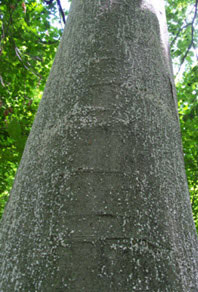
Are you aware that there are over 30 different trees that are native to Michigan? https://www.michigan.gov/documents/IC4212MichiganNativeTrees_139986_7.pdf
With so many different varieties of trees, what difference does it make if Beech trees are in decline from disease? The fact is the American Beech tree is in trouble. According to the Michigan.gov. website: “Beech bark disease (BBD) is caused by both a sap-feeding scale insect and a fungus. American beech trees are first infested with beech scale. Scale feeding allows infection by the Neonectria fungus. The fungus kills the wood, blocking the flow of sap. Affected trees decline in health and eventually die. There are 32 million American beech trees in Michigan. About 2.5 million beech have been killed by BBD to date. Much of this loss has been in the eastern Upper Peninsula. Newly infested beech forests are reported in the Lower Peninsula every year.”
The Emerald Ash Borer is a threat to the Ash trees in Michigan. Dutch Elm disease threatens Elm trees, I could go on listing all the natural threats to our trees in Michigan, however, the greatest threat to our trees is mankind. Humans have a habit of monetizing everything we can. Trees have been under siege for hundreds of years, but in the last hundred years, it has increased exponentially.
I will circle back now answer why tree diversity matters. If so many trees are at risk from disease and all those trees die in that species, the animals, plants and soil will be impacted.
According to Bringing Nature Home by Douglas Tallamy, American Beech provides food for the caterpillars of over 100 species of butterflies and moths. Among them is the Early Hairstreak butterfly, a rare species found in deciduous or mixed woodlands from the maritime provinces of Canada to northern Michigan and Wisconsin through the Appalachians to Tennessee and North Carolina. Early Hairstreak caterpillars can only eat the leaves of American Beech and Beaked Hazelnut (Corylus cornuta). The presence of caterpillars attracts predatory insects and arachnids to feed on them, including many species of spiders, wasps, ants and flies. American Beech develops natural cavities that provide nesting sites for cavity nesting birds like Titmice, Chickadees, Woodpeckers and Nuthatches, all of whom rely on insects for a large part of their diet, and will help protect the tree from insect leaf-eaters. Chipmunks, squirrels, porcupines and other mammals also take advantage of the natural shelter American Beech offers
https://the-natural-web.org/2015/01/09/american-beech/ Please visit this link for more animals and plants that depend on the American Beech tree for survival. This is just one example of why tree diversity is essential to a healthy ecosystem.